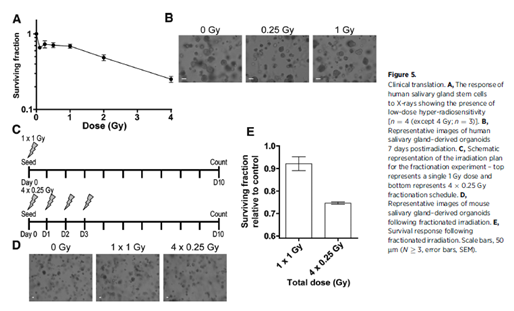(구)글로벌 핫이슈
방사선종양학
- [Clin Cancer Res.] 성체줄기세포에서 방사선저선량에 대한 DNA 손상 반응 결핍이 장기 부전에 미치는 영향 Lack of DNA Damage Response at Low Radiation Doses in Adult Stem Cells Contributes to Organ Dysfunction.
University Medical Center Groningen / Rob P. Coppes*
- 출처
- Clin Cancer Res.
- 등재일
- 2018 Dec 15
- 저널이슈번호
- 24(24):6583-6593. doi: 10.1158/1078-0432.CCR-18-0533. Epub 2018 Aug 22.
- 내용

Abstract
PURPOSE:
Radiotherapy for head and neck cancer may result in serious side effects, such as hyposalivation, impairing the patient's quality of life. Modern radiotherapy techniques attempt to reduce the dose to salivary glands, which, however, results in low-dose irradiation of the tissue stem cells. Here we assess the low-dose sensitivity of tissue stem cells and the consequences for tissue function.EXPERIMENTAL DESIGN:
Postirradiation rat salivary gland secretory function was determined after pilocarpine induction. Murine and patient-derived salivary gland and thyroid gland organoids were irradiated and clonogenic survival was assessed. The DNA damage response (DDR) was analyzed in organoids and modulated using different radiation modalities, chemical inhibition, and genetic modification.RESULTS:
Relative low-dose irradiation to the high-density stem cell region of rat salivary gland disproportionally impaired function. Hyper-radiosensitivity at doses <1 Gy, followed by relative radioresistance at doses ≥1 Gy, was observed in salivary gland and thyroid gland organoid cultures. DDR modulation resulted in diminished, or even abrogated, relative radioresistance. Furthermore, inhibition of the DDR protein ATM impaired DNA repair after 1 Gy, but not 0.25 Gy. Irradiation of patient-derived salivary gland organoid cells showed similar responses, whereas a single 1 Gy dose to salivary gland-derived stem cells resulted in greater survival than clinically relevant fractionated doses of 4 × 0.25 Gy.CONCLUSIONS:
We show that murine and human glandular tissue stem cells exhibit a dose threshold in DDR activation, resulting in low-dose hyper-radiosensitivity, with clinical implications in radiotherapy treatment planning. Furthermore, our results from patient-derived organoids highlight the potential of organoids to study normal tissue responses to radiation.
Author informationNagle PW1,2, Hosper NA1,2, Barazzuol L1,2, Jellema AL1,2, Baanstra M1,2, van Goethem MJ1,3, Brandenburg S3, Giesen U4, Langendijk JA1, van Luijk P1, Coppes RP5,2.
1
Department of Radiation Oncology, University Medical Center Groningen, University of Groningen, Groningen, the Netherlands.
2
Department of Cell Biology, University Medical Center Groningen, University of Groningen, Groningen, the Netherlands.
3
KVI Center for Advanced Radiation Technology, University of Groningen, Groningen, the Netherlands.
4
Physikalisch-Technische Bundesanstalt (PTB), Braunschweig, Germany.
5
Department of Radiation Oncology, University Medical Center Groningen, University of Groningen, Groningen, the Netherlands. r.p.coppes@umcg.nl.
- 덧글달기










편집위원
두경부암환자에서 방사선치료기술의 발전으로 IMRT를 적용하더라도 만성합병증으로 침샘기능저하가 생기는 것을 피할 수 없는데, IMRT가 parotid gland에 조사되는 mean dose를 줄일 수는 있지만 저선량이 조사되는 전체 용적이 증가하는 물리적 특성에 의해 stem cells의 low-dose radiation sensitivity가 발생한다는 동물실험으로써 흥미로운 연구입니다.
2019-01-23 14:13:57